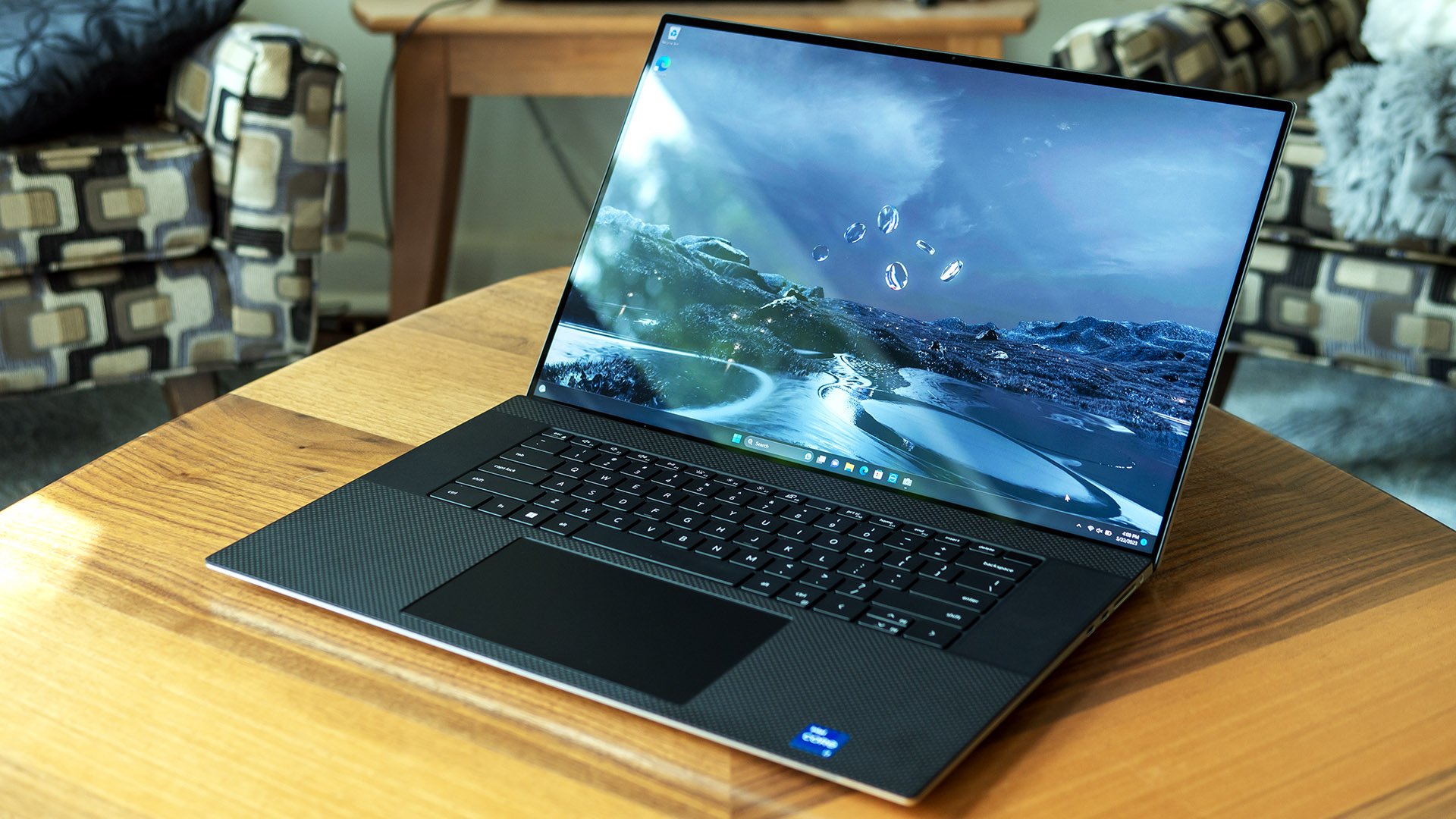
High-performance, big-screened laptops don’t have to be for gaming. Dell’s flagship XPS 17 is certainly capable of a frag session, thanks to its Intel “Raptor Lake” H-class processor and Nvidia GeForce RTX 40 series graphics, but it’s more aimed at prosumers seeking a powerful laptop with a huge, stunning screen; perhaps something like the best ultrabooks, but with extra muscle. The XPS 17 delivers on that front and then some, though we’d like to see this model refreshed with a higher-resolution webcam and a better keyboard. A few more ports wouldn’t hurt, either.
Design of the Dell XPS 17 (9730)
The XPS 17 has high-end written all over it – everything you see and touch is aluminum, carbon fiber, or glass. Unlike thin stamped aluminum typically used on cheaper laptops, the XPS 17’s lid and chassis bottom are machined from one aluminum block. The laptop is exceptionally strong and almost completely resists flexing.

The XPS 17’s bright silver exterior and dark carbon fiber interior contrast nicely. Its huge 17-inch screen has very thin bezels even on the oft-neglected bottom edge, thanks to its specially engineered hinge. The hinge is stiff enough to keep the display from wobbling when you touch it, but not overly so – it can still be opened one-handed.
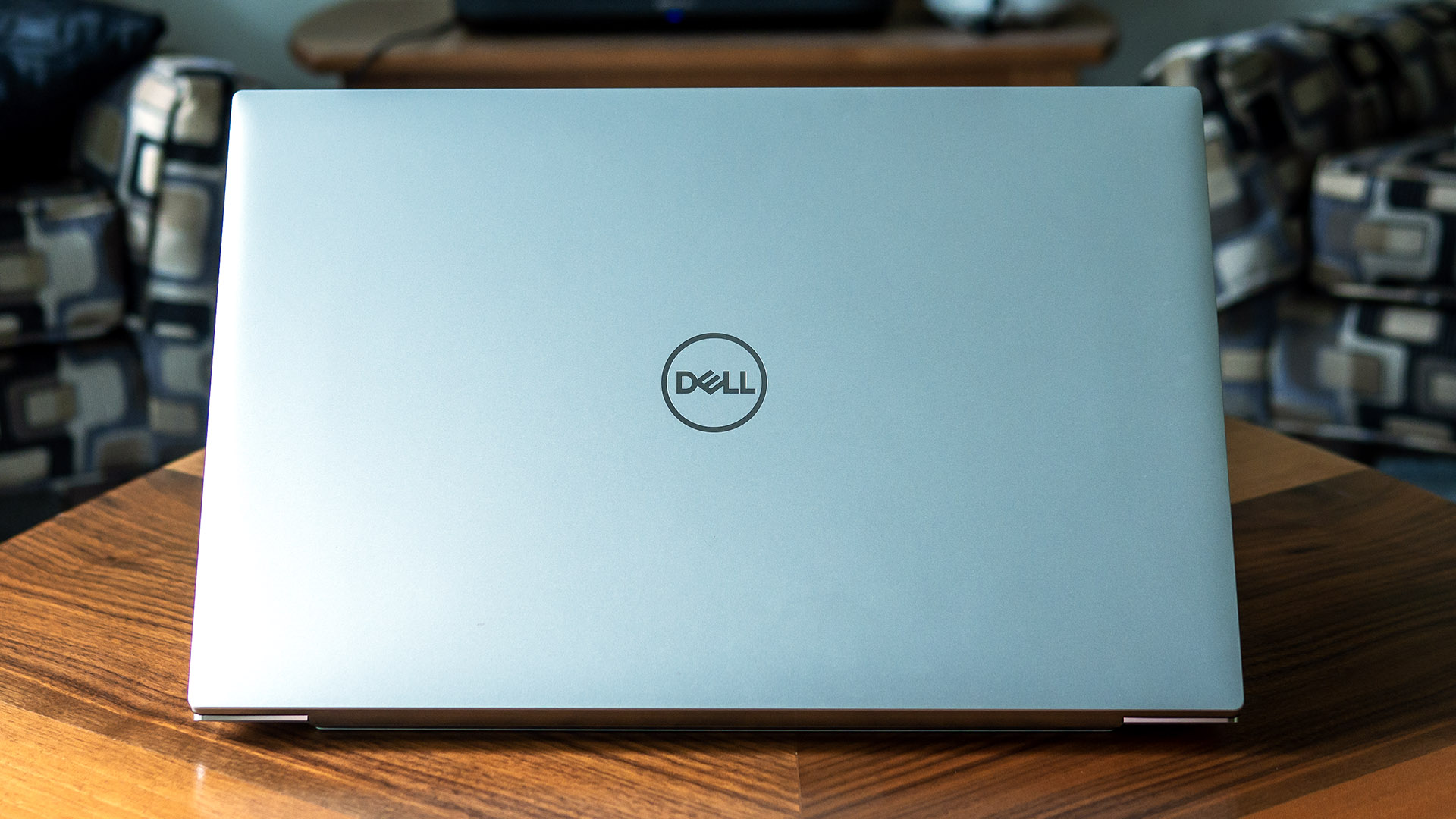
Looking down, you’ll see the carbon fiber weave in the palm rest, which is covered in a soft-touch silicone coating. You’ll also notice the speaker grilles flanking the keyboard aren’t separate pieces but part of the deck. Each grille hole (all 7,622 of them) is laser-drilled.
But wait, there’s more on the XPS 17’s underside. All the openings and perforations here are machined, too. Even the regulatory labels are laser-etched instead of being inked on. The XPS logo probably tops everything; it’s stainless steel, not plastic, and lives in another machined cutout. "Obsessive" is the right word for this laptop’s attention to detail.
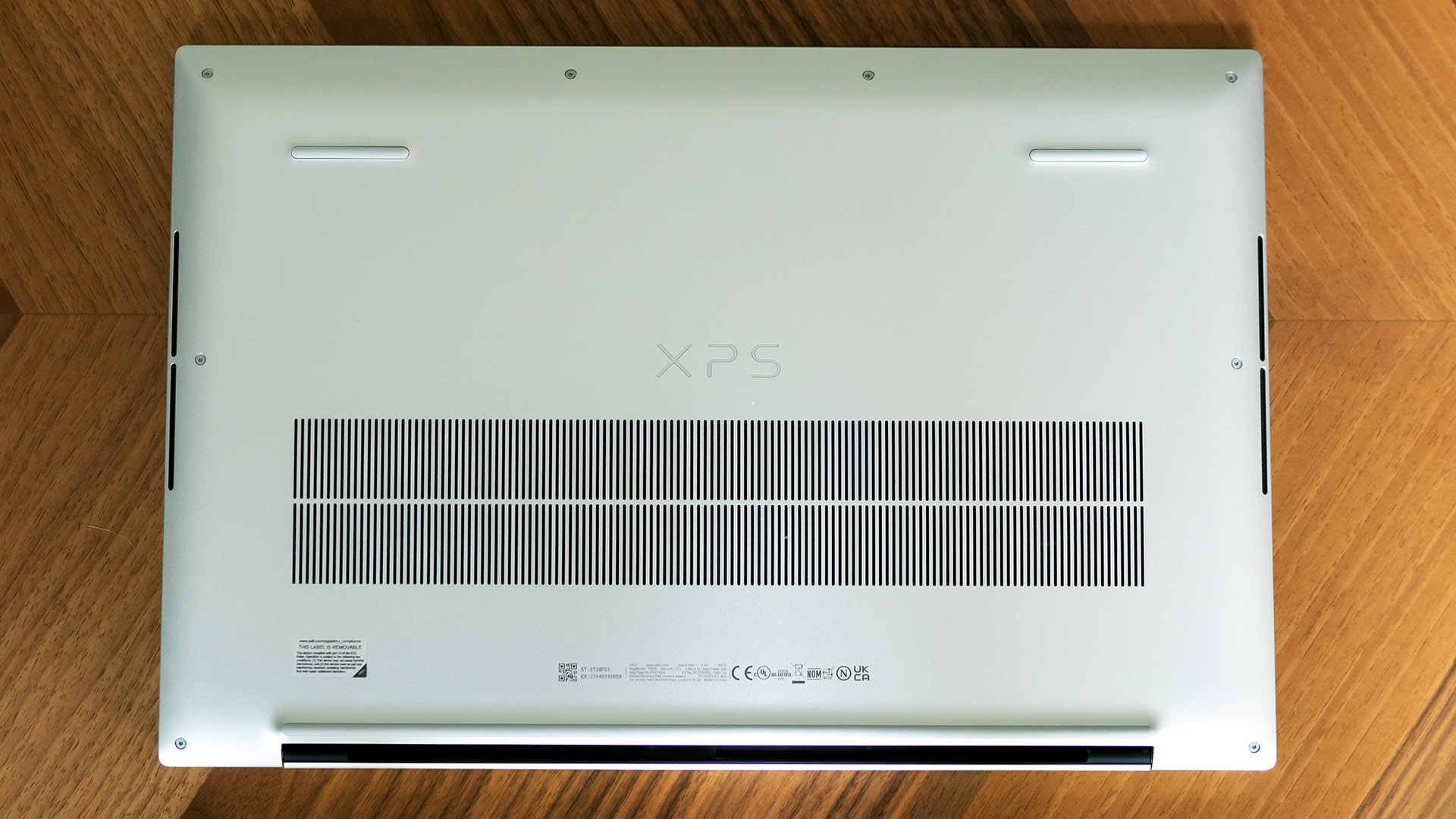
Detail aside, I’d like to see Dell refresh the XPS 17’s design looks along the lines of its XPS 13 Plus (which, admittedly, may be controversial even among Tom's Hardware writers), as this big-screened laptop hasn’t seen a refresh in a few years. It still looks great but it’s no longer the leader in style.
At 14.74 x 9.76 x 0.77 inches, the XPS 17 is on the thick side but not much bigger than its 16:10 screen in width and depth. It weighs 5.37 pounds with a touch screen as we’re reviewing it, which comes with a Corning Gorilla Glass 6 screen surface. The latter is probably why it weighs more than the 5.1-pound base model, which has a normal anti-glare screen and no touch support.
Size-wise, the XPS 17’s measurements compare favorably even to 16-inch laptops. The
Samsung Galaxy Book 3 Ultra is 13.99 x 9.86 x 0.65 inches and weighs 3.95 pounds. Apple's 2023 16-inch MacBook Pro (14.01 x 9.77 x 0.66 inches and 4.48 pounds) is lighter but also has a similar footprint.
Port variety is where the XPS 17 unfortunately doesn’t take advantage of its size. It has just four Thunderbolt 4 (USB-C) ports (two on either edge), a 3.5 mm headphone/microphone jack, and a full-size SD card reader. That's it.
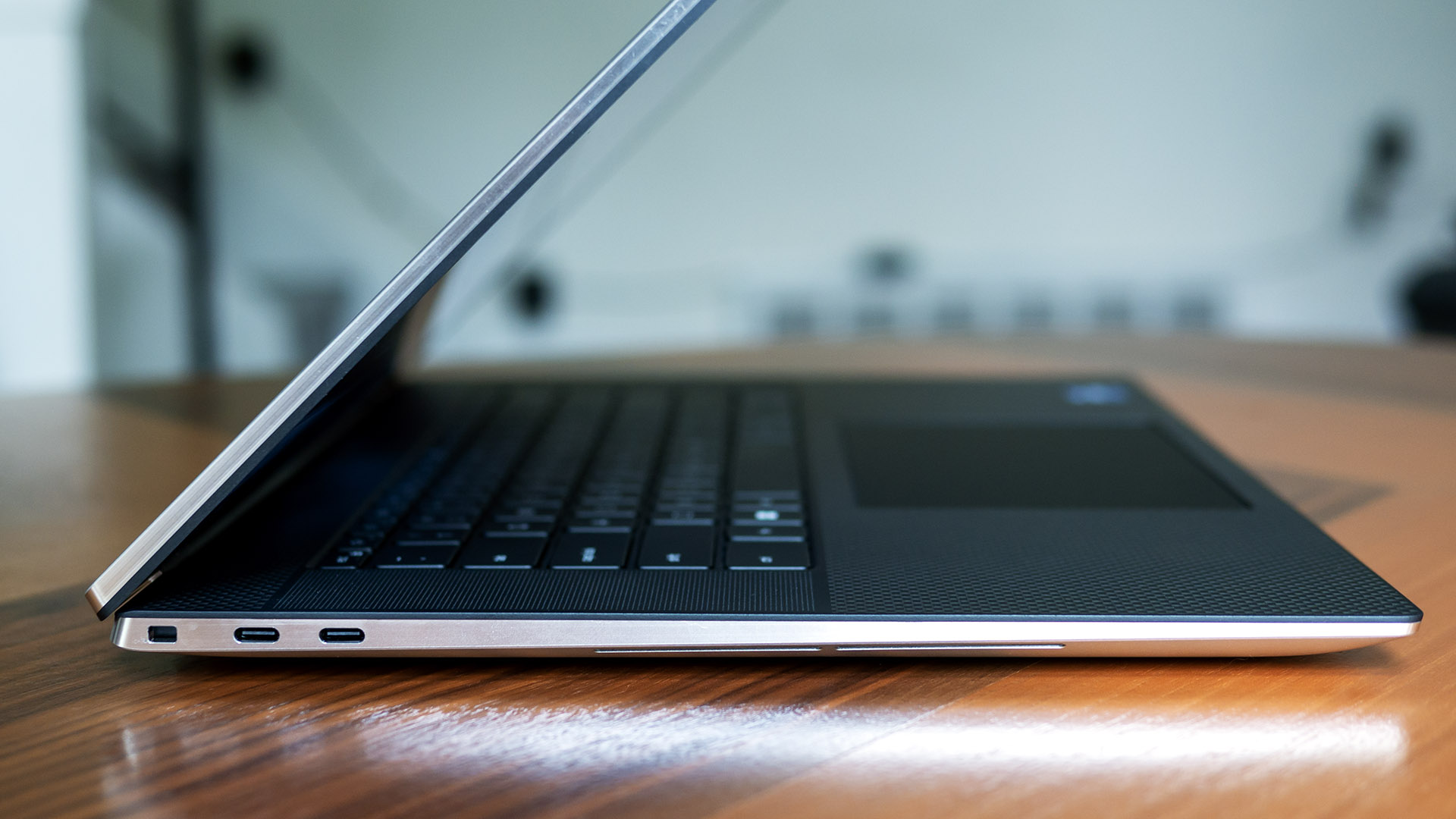
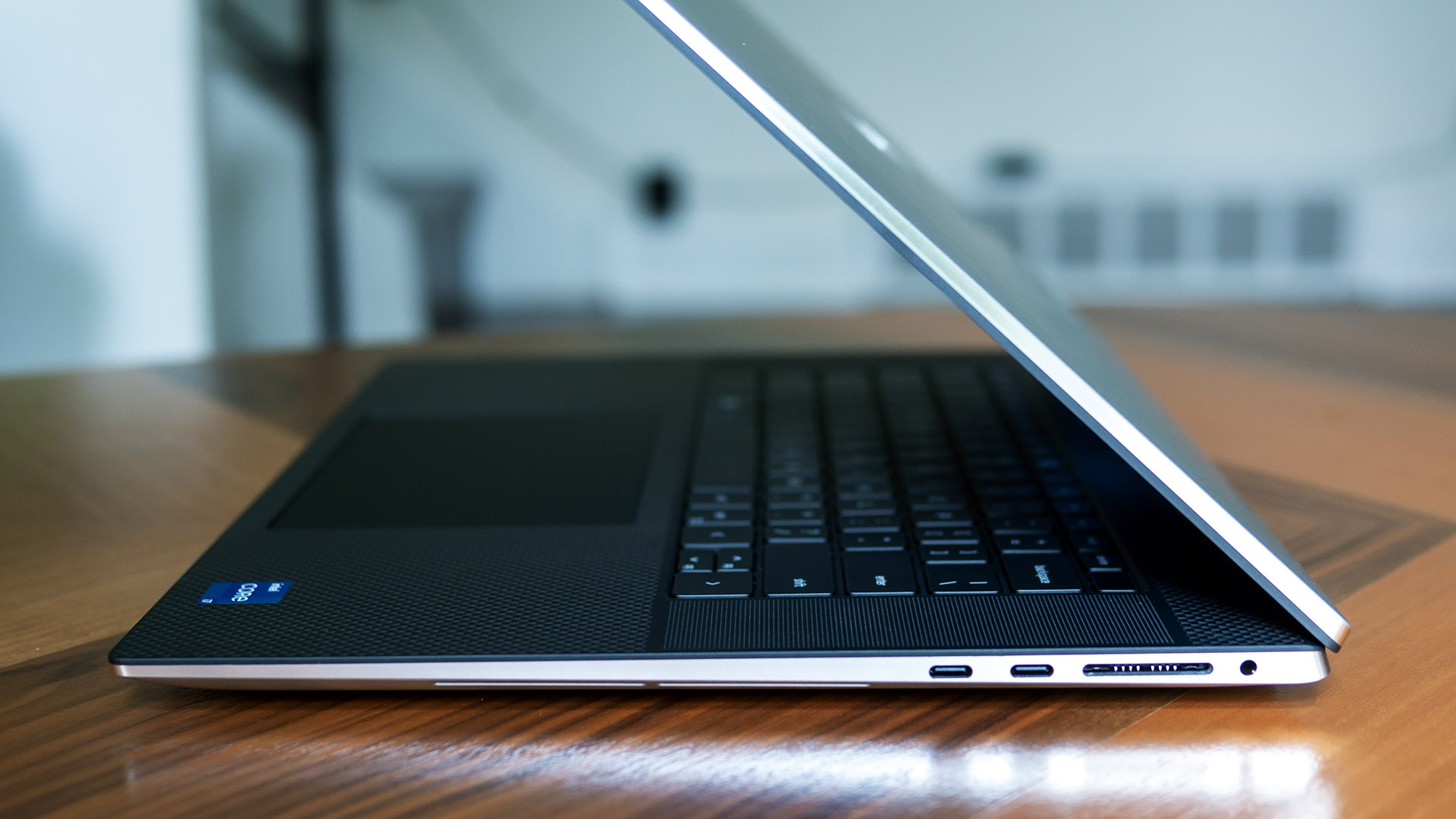
To Dell’s credit, it includes a USB-C to USB-A and HDMI 2.0 dongle in the box, but it’s essentially an omission that the XPS 17’s port selection may not satisfy customer needs. I’d like to see at least one USB-A port and HDMI in a future refresh, even if Dell had to sacrifice a USB-C port for it. For connecting devices without wires, the XPS 17 has built-in Wi-Fi 6E and Bluetooth 5.3 from its Intel AX211 networking card.
Any Thunderbolt 4 port can be used to power the XPS 17. Intriguingly, its USB-C adapter is rated for 130 watts when Thunderbolt 4 is technically limited to 100 watts, so Dell must have done some engineering, as USB4 is rated for 130W.
Dell XPS 17 (9730) Specifications
Productivity and Gaming Performance on the Dell XPS 17 (9730)
We’re reviewing the XPS 17 with an Intel Core i7-13700H processor, Nvidia GeForce RTX 4070 8GB graphics, 32GB of DDR5 RAM, and a 1TB PCI Express 4.0 SSD. Dell bills this as a prosumer and all-around high-performance laptop rather than a gaming machine, though its GeForce RTX graphics cards have the horsepower for modern gaming, as we’ll see later in this section.
For our performance comparisons, we’ve included the 2023 16-inch Apple MacBook Pro, Dell’s outgoing XPS 17 (9720), and the Samsung Galaxy Book 3 Ultra. The Apple and Samsung have 16-inch screens and so are slightly smaller than the XPS 17. The MacBook Pro has Apple’s M2 Max chip and onboard graphics while the Samsung pairs the same Core i7-13700H in our XPS 17 9730 with a GeForce RTX 4050. Meanwhile, the older XPS 17 9720 uses a Core i7-12700H and what was its top GPU option, a GeForce RTX 3060.
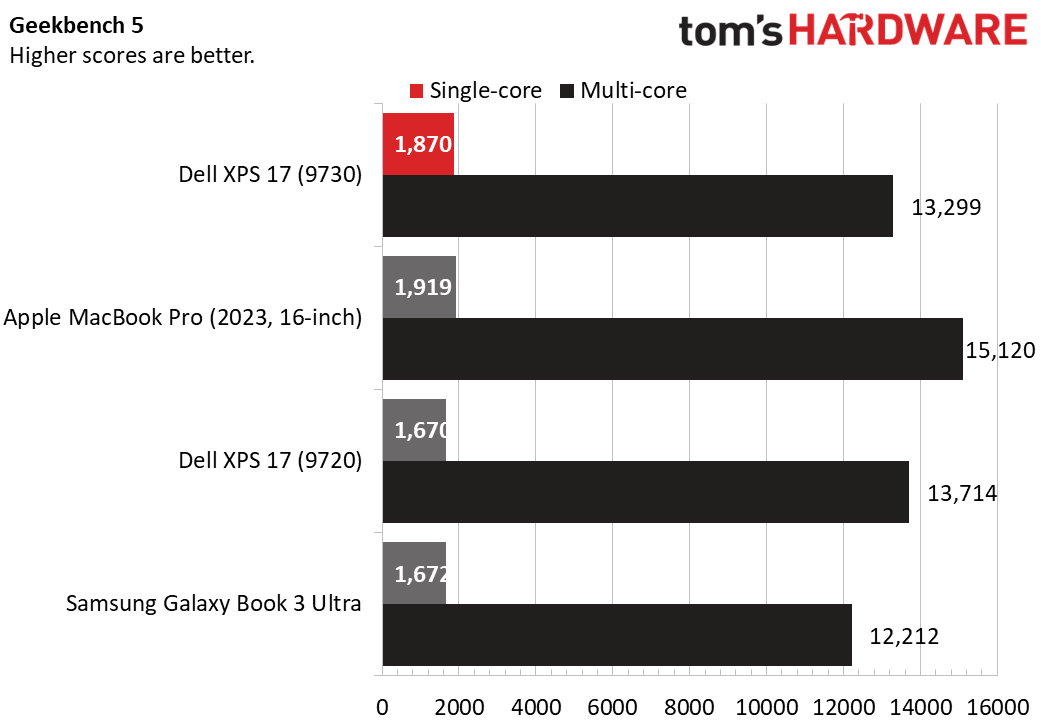
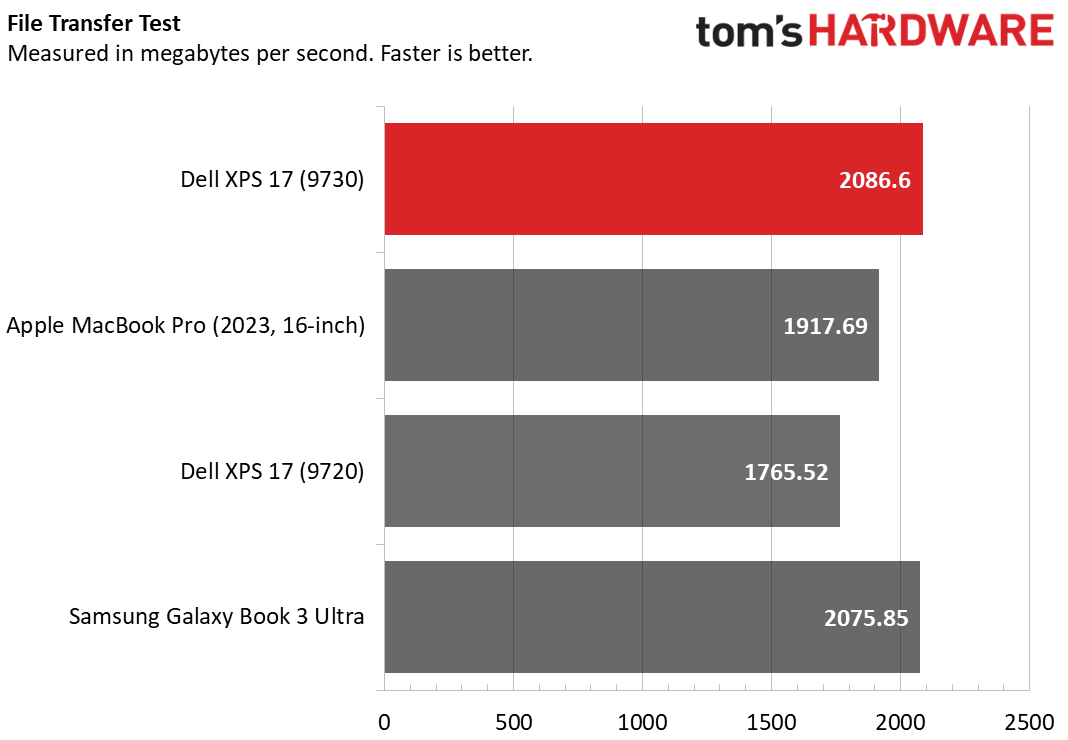
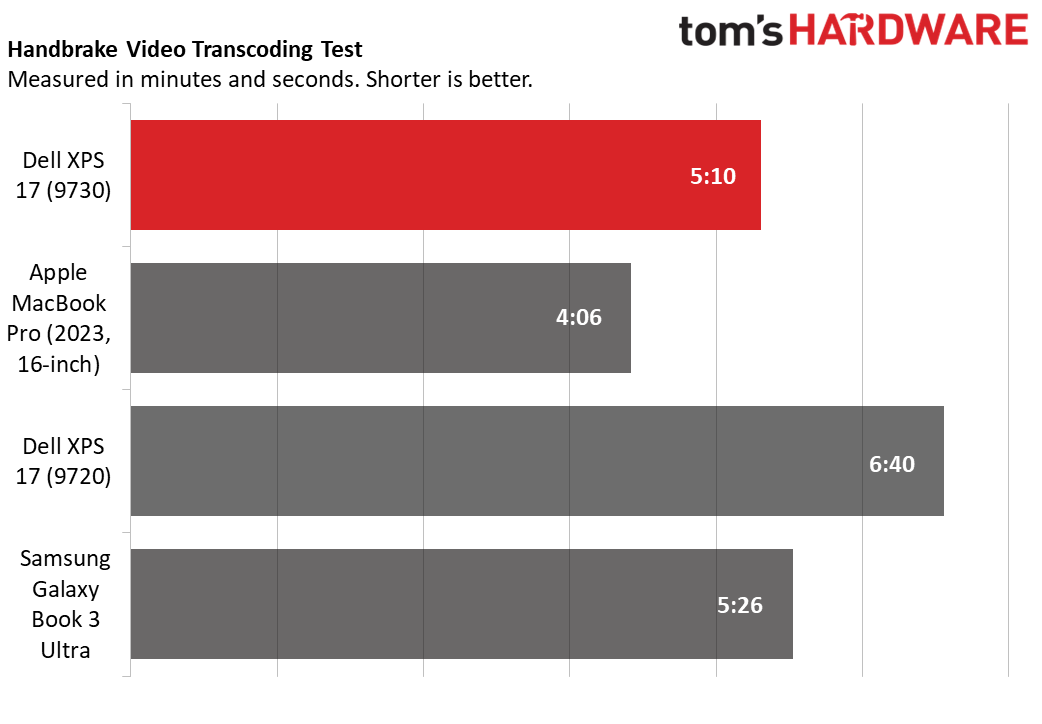
The XPS 17 9730 started off with 13,299 points in the cross-platform Geekbench 5 multi-core test, which looks good next to the Samsung with the same CPU (12,212 points) but somehow didn’t beat the older XPS 17 9720’s 13,714 points. It nonetheless bested the 9720 in the single-core test (1,870 versus 1,670 points). Laptops have notoriously variable thermal and power behavior, so seeing different numbers with equivalent hardware isn’t entirely surprising.
Things improved for the XPS 17 9730 in the Handbrake video transcoding test, where its time of five minutes and 10 seconds was the lowest among the Windows laptops, easily besting its predecessor’s 6:40. None of them could catch the MacBook Pro.
The XPS 17 9730 showed the strongest performance of this group in our 25GB file transfer test, at 2,086.6 MBps versus the Samsung’s next-best 2,075.85 MBps, indicating Dell includes a fairly robust SSD.
We also put productivity-driven laptops through 20 loops of Cinebench R23 CPU stress testing to see how the system’s cooling stands up under extended load. Here, we look for consistency i.e., as straight of a line as possible.
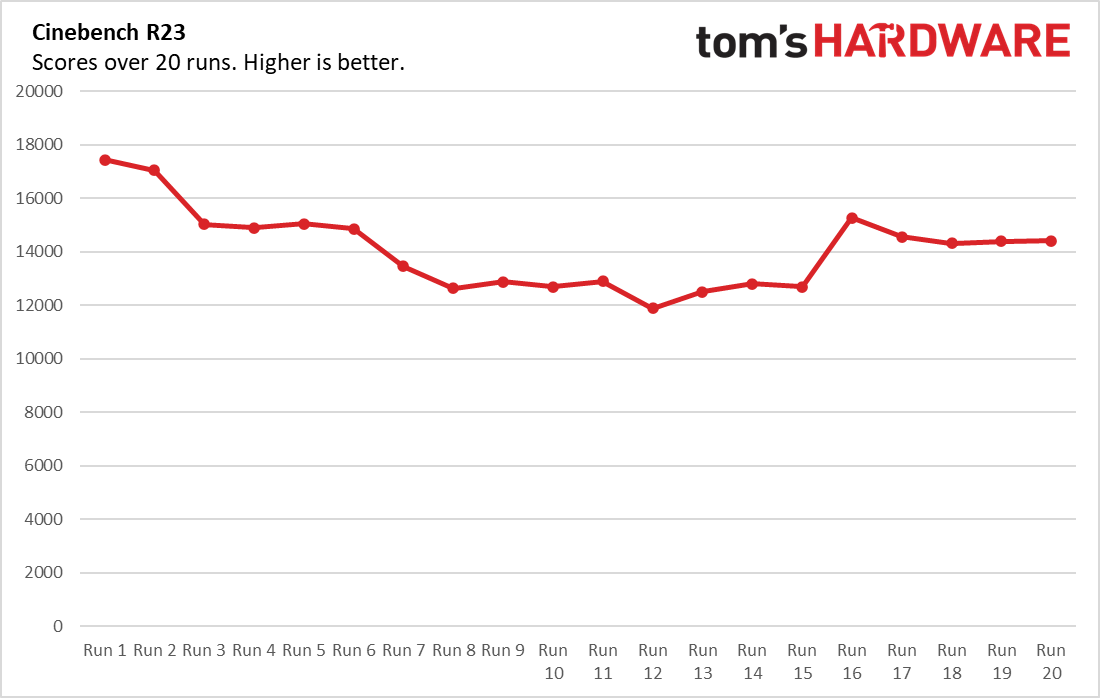
The XPS 17 produced something of a roller coaster line, beginning at 17,340 points before steadily (if not smoothly) dropping to a low of 11,889 points just past halfway through, when the scores improved and stabilized. The last three runs were within 100 points (14,316 to 14,410 points). Setting the XPS 17’s thermal mode to Ultra Performance might help smooth this out. (See the MyDell app explained later in the Software section.)
Graphics Performance on the Dell XPS 17 (9730)
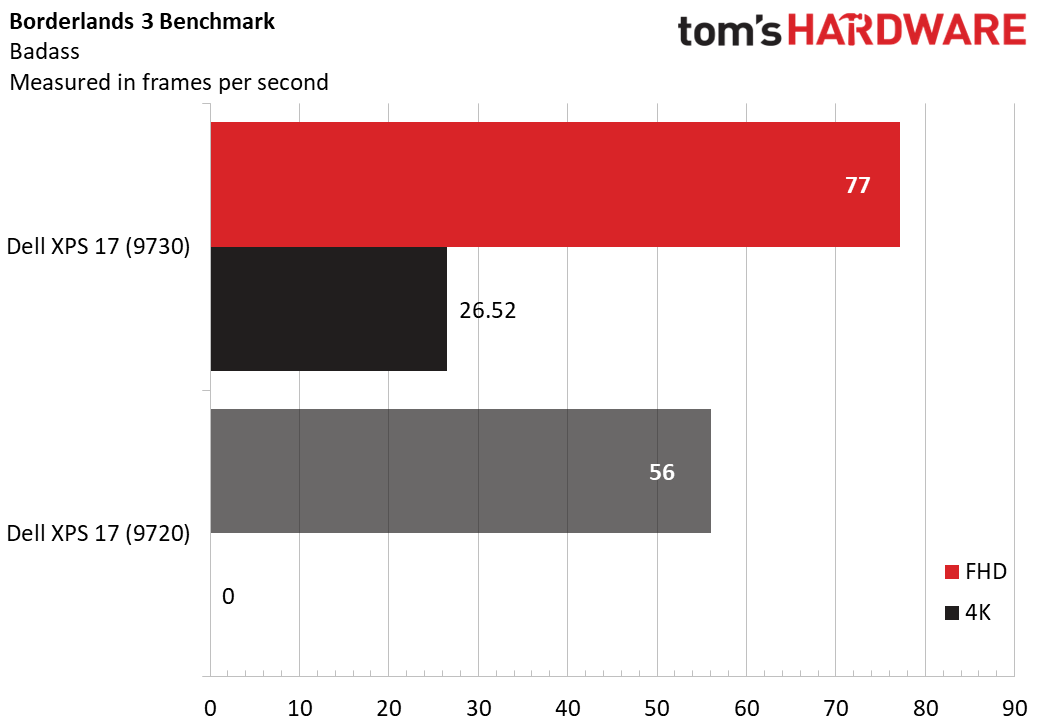
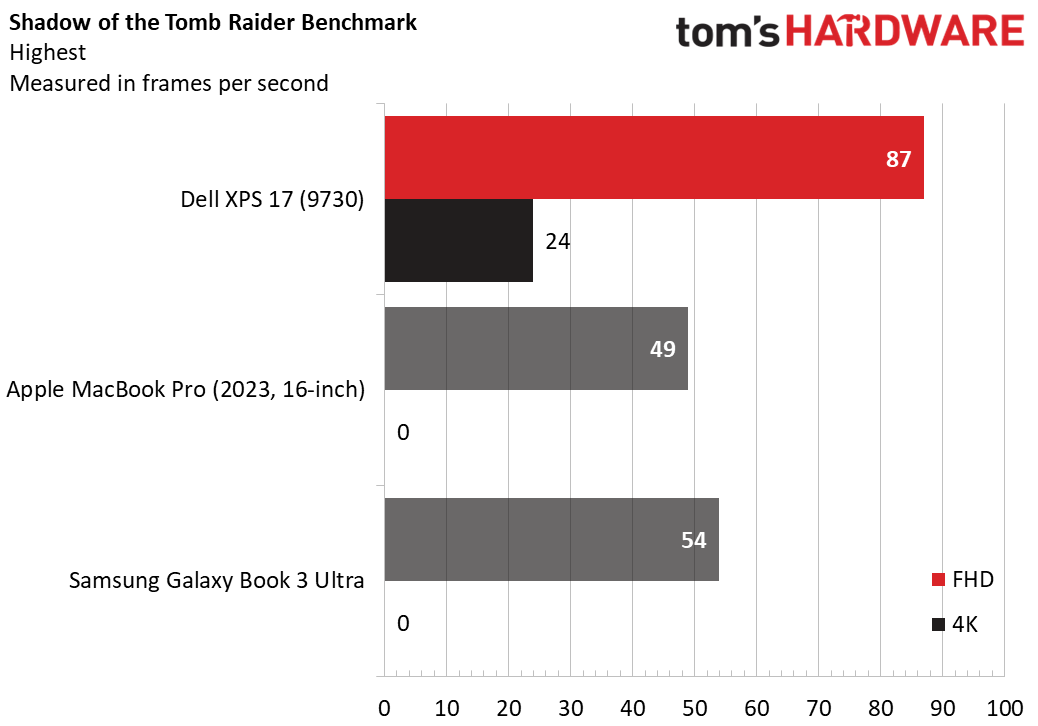
As I noted, Dell intends the XPS 17 9730 to be a high-performance prosumer rather than a gaming laptop, but nothing prevents you from getting a few play sessions in with its GeForce RTX 40 series graphics. Our unit’s RTX 4070 has 8GB of RAM but has a maximum graphics power rating of only 70 watts, which severely limits its potential. It’s realistically limited to 1080p gaming. In Borderlands 3's benchmark at its “Badass” settings, we saw 77 frames per second (fps) at a 1080p resolution but an unplayable 27 fps at the XPS 17’s native 3840 x 2400 resolution. We saw similar performance in the older Shadow of the Tomb Raider, where the XPS 17 produced 87 fps at 1080p but only 24 fps at native. Less demanding games can be playable at native; Sid Meier’s Civilization VI: Gathering Storm saw 122 fps at 1080p and 79 fps at native.
Note that the XPS 17’s screen is limited to 60 Hz, so anything over 60 fps is a moot point. Gamers would be better off sticking with the base model’s 1920 x 1200 screen, but that’s also 60 Hz. All told, this isn’t a great gaming laptop, especially for competitive esports, but it’s capable.
Display on the Dell XPS 17 (9730)
The XPS 17 is known for its quality display. Our review unit's 3840 x 2400 screen is Dell’s top option, with a blazing 500-nit rated brightness, touch support and, as our colorimeter revealed below, impressive color coverage.
The display is so colorful that I thought it was oversaturated as I watched Top Gun: Maverick, but it was just plain fun to watch Finding Nemo. Looking at this display exudes the feeling you get in a retail TV store when you look at the stunning images on the most expensive TVs. Deep black levels are also one of this screen’s great qualities; even in movies shot in 16:9, which show black borders on the XPS 17’s 16:10 screen, the borders are hardly noticeable in a darker room.
This screen also surprises in that, despite having a Gorilla Glass 6 surface, it mitigates reflections well, thanks to a mild anti-reflective coating. It still looks like glass but doesn’t suffer from mirror-like reflections.
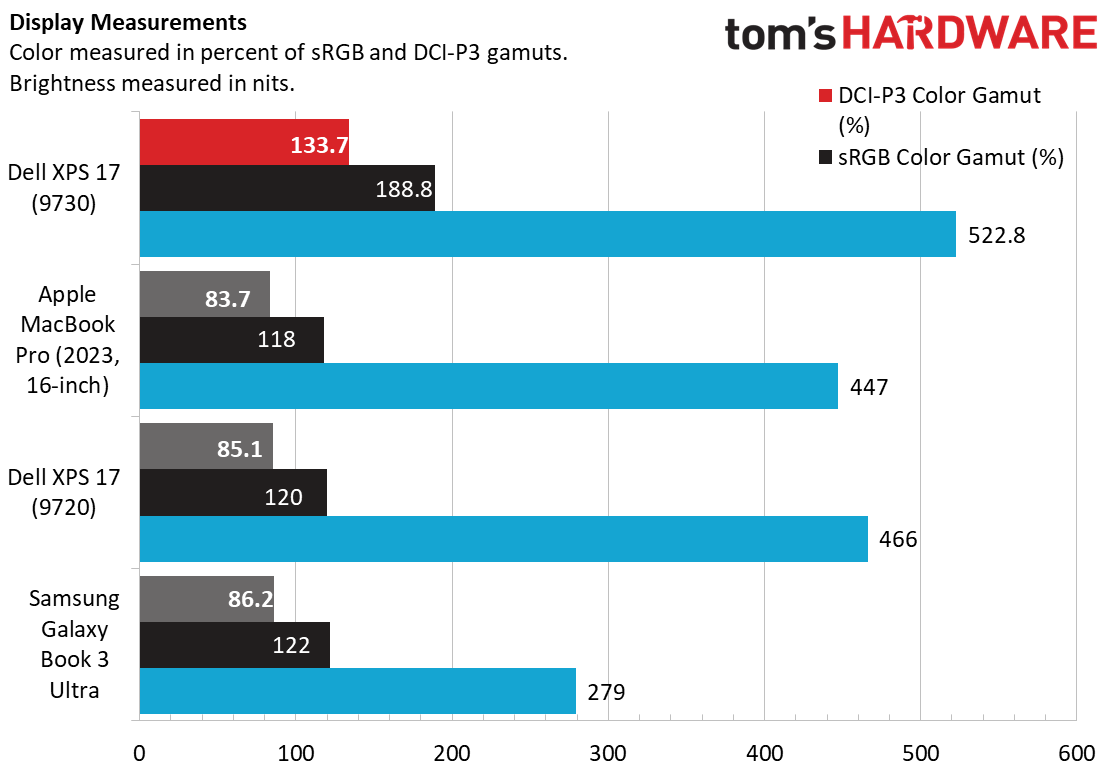
The XPS 17 9730 wows across the board, when it comes to our colorimeter, especially with its crazy 133.7% coverage of DCI-P3 color, which we don’t even see on OLED screens. Its 522.8-nit average brightness also blew away the rest of the pack and exceeds Dell’s own rating. (And that’s average brightness; we recorded 564 nits in the center of the display.) Dell clearly improved this display since we reviewed the XPS 17 9720, which had the same basic panel.
Keyboard and Touchpad on the Dell XPS 17 (9730)
The XPS 17’s touchpad is one of its best assets. It’s massive, at nearly six inches wide and 3.5 inches tall, making it perfect for pinching and swiping. Physical clicks (accomplished by pressing the pad’s surface) are quiet, tactile, and require just the right amount of pressure. The anti-glare surface resists smudges well.
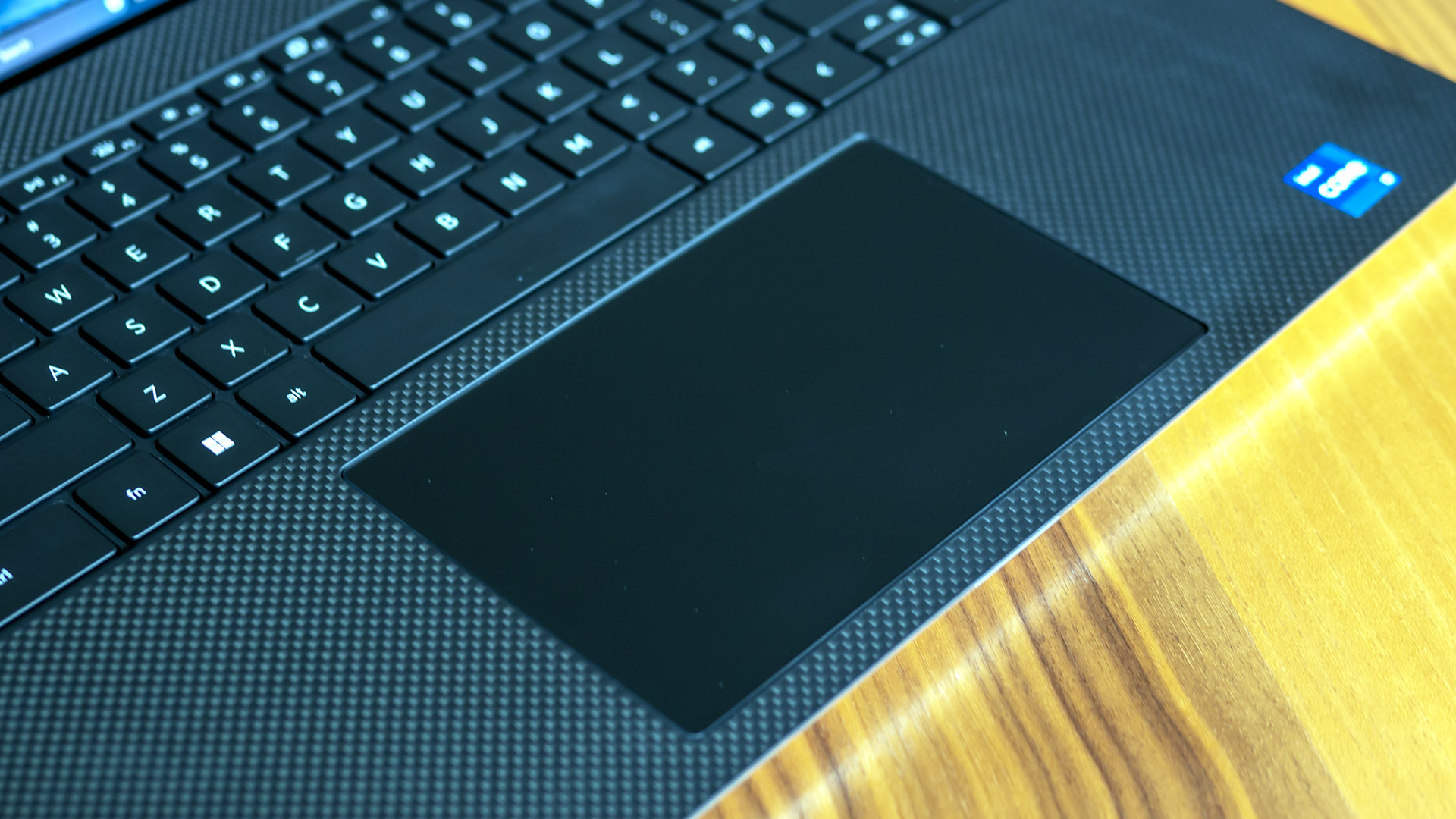
The keyboard is, unfortunately, ho-hum. The high contrast keys look chic, especially with two-level white backlighting, but feel lifeless. The key culprit (pun intended) is their limited travel distance, which is strange on a laptop this large.
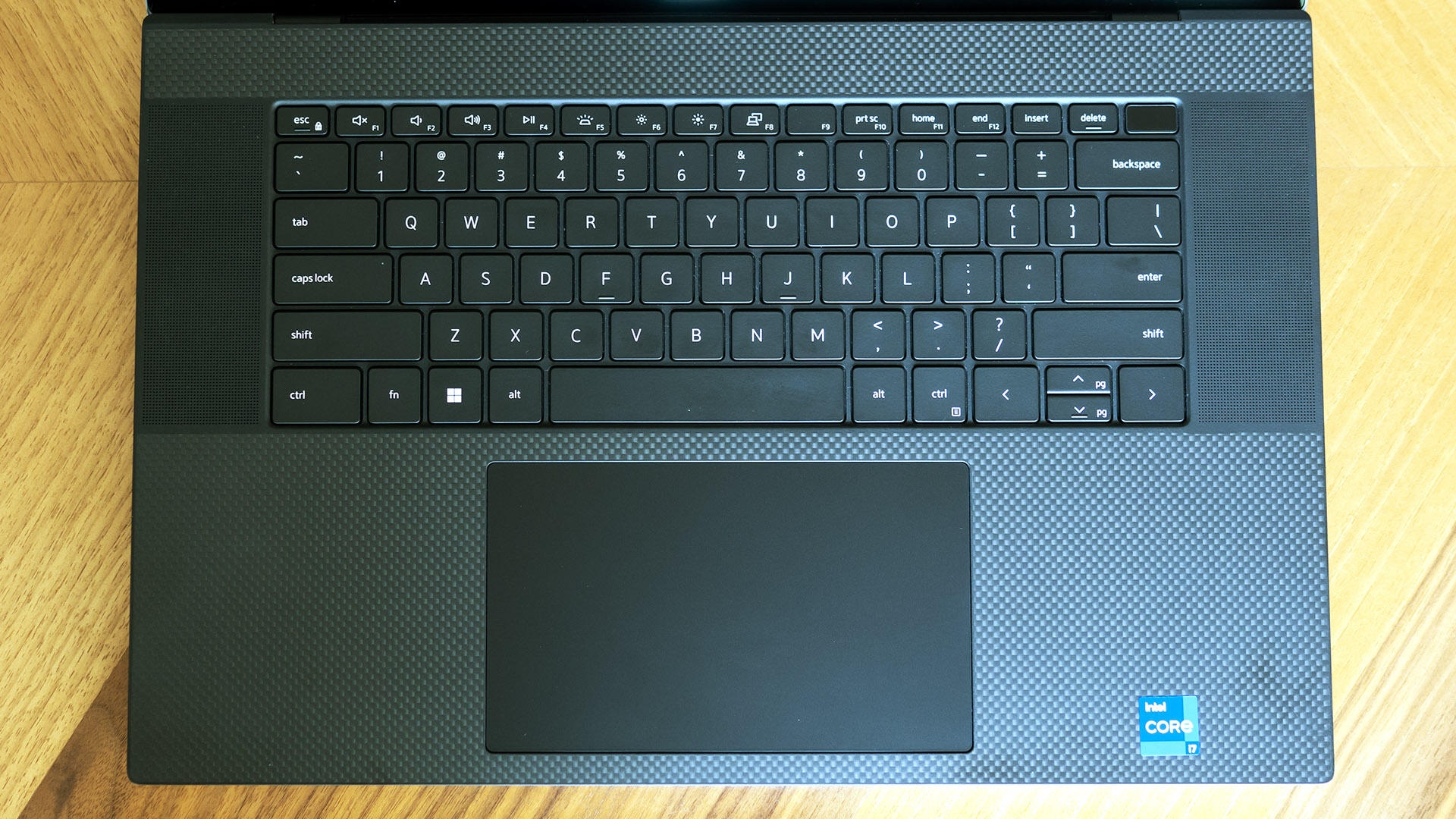
The layout could be improved, too. Though there are dedicated Home, End, Page Up and Page Down keys along the top row, Dell sandwiched half-size up and down arrow keys between full-size left and right arrow keys, and I was constantly fat-fingering them. They should have all been the same size. Meanwhile, the power button is at the top right corner and doubles as a fingerprint reader. It took only a few minutes to set up (in Windows’ sign-in options) and worked great.
I also wonder why the XPS 17 doesn’t include a number pad like many (most?) laptops this size, because it clearly seems wide enough. Add that to my next-generation wish list.
At least my typing accuracy didn’t suffer; I managed 108 words per minute with 99% accuracy using the Monkeytype typing test, which is about as good as I can do. All told, the XPS 17’s keyboard is perfectly functional but not exciting.
Audio on the Dell XPS 17 (9730)
The XPS 17 can really fill the room with its quad-speaker setup, which consists of two woofers and two tweeters. The woofers are below the palm rest and the tweeters flank the keyboard. The laptop needs to sit on a flat surface to sound its best.
The XPS 17 made watching the Mission Impossible: Dead Reckoning trailer almost seem like I was in a mini-movie theatre. Their surround-sound effect is convincing. Bass isn’t booming but gunshots and well-landed punches had the right effect. Vocal clarity impressed me the most; the upward-facing tweeters are probably responsible for that.
In music, Push by Matchbox Twenty had a pleasant airy sound, with good separation between drums and vocals. Bass isn’t the speakers’ strong suit, as I noted; nonetheless, I could tell the bass was there in Spencer Davis Group’s Gimme Some Lovin’. The sound is anything but flat. Overall, the XPS 17 has a stellar audio setup for a laptop. It could easily substitute for a small Bluetooth speaker in a pinch. The only possible disappointment is that there isn’t a dedicated app to control the sound, so you don’t have any equalizer settings.
Upgradeability of the Dell XPS 17 (9730)
The XPS 17 offers reasonable upgradeability, including two DDR5-4800 SODIMM slots and two M.2 2280 SSD slots. It supports 64GB of RAM (two 32GB modules) and 8TB of storage (two 4TB drives). The battery can also be replaced, though the wireless card is soldered and not upgradeable.
Eight Torx T6 screws secure the XPS 17’s bottom panel. Once they’re removed, you’ll need a plastic pry tool no thicker than a credit card to pop the clips around the edges. I started at the back near the air vents. The force I had to use nearly broke my pry tool. Keep in mind the bottom panel is one piece, so you’ll be prying between the silver aluminum and dark carbon fiber halves of the chassis.
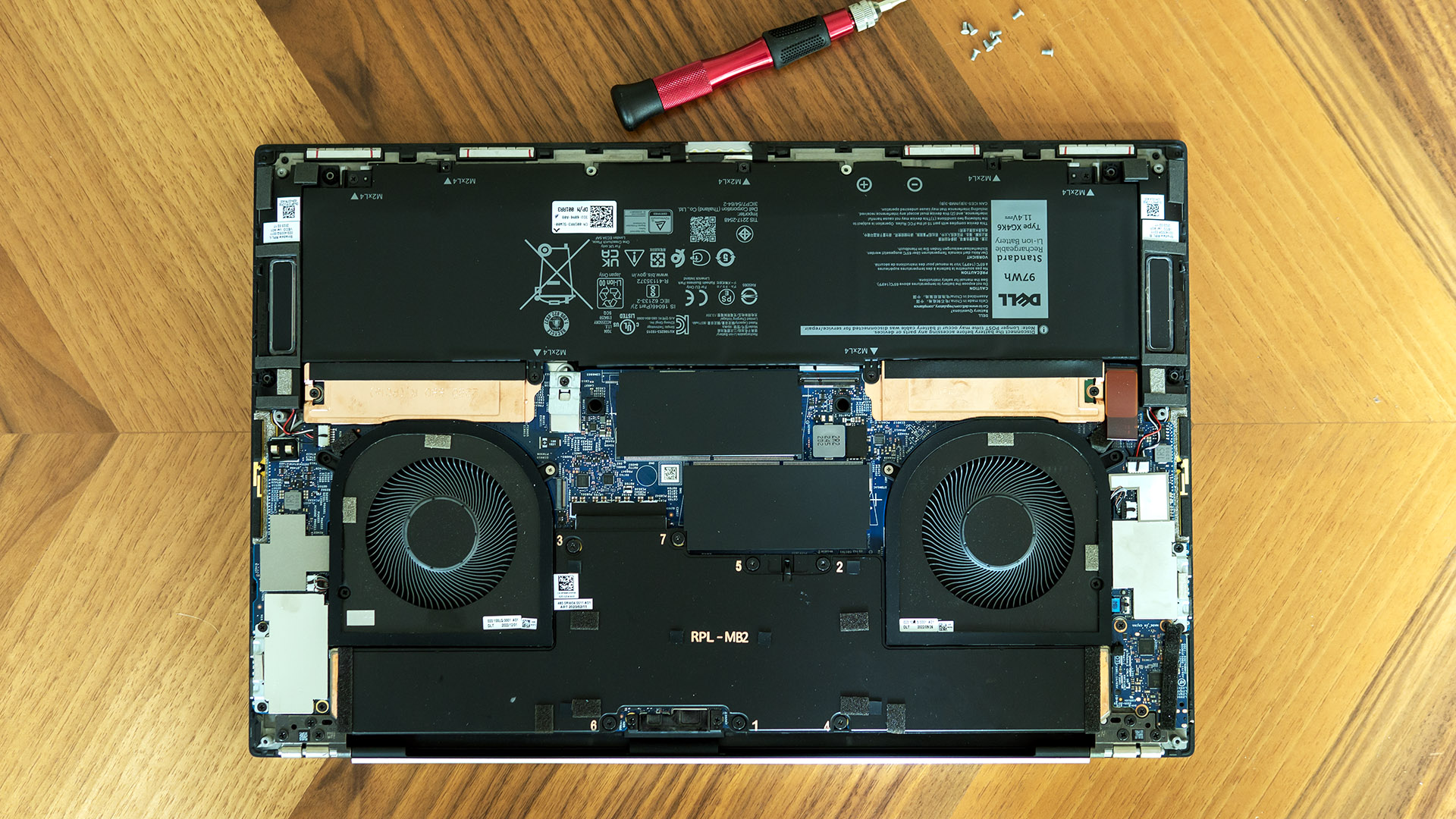
The M.2 and SODIMM slots are across the center. Dell includes heatsinks for both M.2 slots even if you don’t order the laptop with two drives. The massive 97 WHr battery spans the top while a nearly chassis-width vapor-chamber heatsink sits between the two cooling fans.
Battery Life on the Dell XPS 17 (9730)
Gone are the days when big laptops couldn’t last long off the plug. The XPS 17’s ability to automatically switch to its onboard Intel graphics via Nvidia Optimus and its powerful 97 Wr battery helped it last nine hours and six minutes during our battery test, which consists of continuous web browsing, streaming video, and OpenGL simulations over Wi-Fi at 150 nits of screen brightness. That’s over half an hour more than the outgoing XPS 17 9720 and even keel with the Samsung Galaxy Book 3 Ultra, which has a smaller screen. It couldn’t touch the MacBook Pro’s incredible runtime, though.
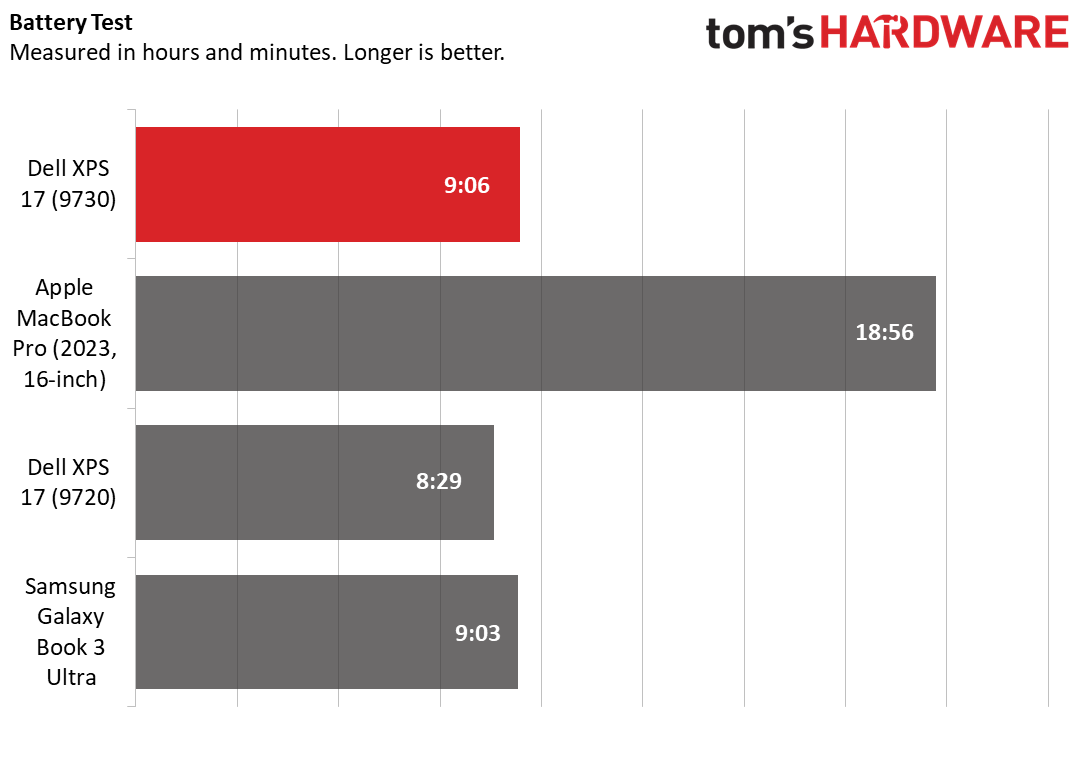
Heat on the Dell XPS 17 (9730)
We measure laptop surface temperatures during a 20-loop run of the Cinebench R23 CPU stress test. The XPS 17’s keyboard center measured just 101.5 degrees Fahrenheit (38.6 degrees Celsius) and the touchpad at 91.9 F (33.2 C). The peak temperature on the laptop’s bottom panel was 96.1s F (35.6 C). The XPS 17 felt lukewarm all over, which I felt safe touching. The fans are subdued and not too distinguishable over the usual household noise. I couldn’t hear them at all through my open headphones.
Webcam on the Dell XPS 17 (9730)
As we mentioned the last time we reviewed this chassis, the XPS 17 needs a 1080p (or better) webcam upgrade. Its 720p camera is not up to par. Here’s me in the XPS 17’s 720p webcam, no circa-2010 filter needed.

Pixelation is obvious and I also found the camera struggles with highlights and noise even in good lighting. Its only redeeming quality is that it supports infrared, so it works for facial recognition (Windows Hello). But for anything more than an I-don’t-care-how-I-look chat, check out our list of best webcams.
Software and Warranty on the Dell XPS 17 (9730)
The XPS 17 is free of unwanted software and trial apps. Dell includes a 12-month subscription to McAfee LiveSafe instead of the usual trial. It also installs several of its own apps, the most important of which is MyDell.
MyDell’s most intriguing feature is Power, which lets you customize the laptop’s charging mode for optimum battery health or the quickest charging time, depending on your usage. It can even tell the laptop to run exclusively off battery or AC power on a schedule. Given the XPS 17’s long battery life, I could see this being useful to have the laptop run on battery during the day and charge after peak hours when electricity is cheaper.
You’ll also find thermal management settings in MyDell; the Quiet and Cool modes restrict fan usage but also cause the laptop to throttle and cut performance. The Ultra Performance mode makes the fans noticeable but can be worth using if your workflow is hammering the CPU or GPU, as the aggressive fans should help those components maintain their boost clocks. The default power mode is Balanced, which we used for all testing.
MyDell also lets you download any apps you purchased with the laptop and choose from different display color profiles, including Internet, Cinema, HD Video, Photos, and one called Vibrant. You can also create your own. Other Dell apps include Dell Update for driver and firmware updates and SupportAssist for getting remote help from Dell Support.
The XPS 17 has a one-year warranty and includes Dell’s premium support tier.
Dell XPS 17 (9730) Configurations
The XPS 17 9730 starts at $2,449 as of this review’s publishing, with an Intel Core i7-13700H processor, Nvidia GeForce RTX 4050 6GB graphics, 16GB of RAM, a 512GB SSD and a 1920 x 1200 non-touch screen. Our $3,349 review model ups those specs to a GeForce RTX 4070 8GB, 32GB of RAM, a 1TB SSD, and a 3840 x 2400 touch screen.
The highest-end models can be had with a Core i9-13900H, 64GB of RAM, and 8TB (2x 4TB SSDs) of storage. A GeForce RTX 4080 with 12GB of dedicated memory is also available, though as mentioned earlier, all the Nvidia cards offered in this laptop are capped at a low 60 or 70 watts of maximum graphics power. Intel vPro remote management is available with select CPUs, so the XPS 17 could be deployed in enterprise environments.
Less expensive models aren’t yet available – Dell still has the outgoing (but physically identical) 9720 model as the budget option, which starts at $1,299 with a Core i5-12500H, integrated Intel graphics, 16GB of RAM, a 512GB SSD and a 1920 x 1200 non-touch screen. Core i5 processors will eventually make their way into the 9730 and lower its price.
Dell also says it will offer Creator editions of the XPS 17 9730, which will have special Nvidia graphics drivers optimized for creative apps like Adobe Photoshop.
Bottom Line
The Dell XPS 17 remains our top pick among high-end 17-inch performance laptops running Windows. There’s nothing cheap about it, including its price; $3,349 for our test model is borderline eye-watering, though as of this writing, you can get the outgoing but physically identical XPS 17 9720 model for as little as $1,299, and still under $2,000 with its stunning 4K touch screen and a dedicated graphics card.
Most of the XPS 17’s competition uses 16-inch screens, namely the Samsung Galaxy Book 3 Ultra and the Apple MacBook Pro. The Samsung is less expensive, offers comparable battery life and has a number pad, though it tops out with an Nvidia RTX 4050, a 2880 x 1800 screen, and its RAM can’t be upgraded. The MacBook Pro is hard to beat, though you’ll probably spend at least as much for it and it involves switching to MacOS.
Performance-wise, the XPS 17’s 13th gen Intel processor offers a mild but important boost over the outgoing 12th gen chips in the XPS 17 9720, especially in single-threaded and long-running workloads. You also get newer Nvidia RTX 40 series graphics; they’re much lowered powered than they are in gaming laptops but still far superior to integrated graphics for GPU-accelerated workflows. And all that performance doesn’t have any strings attached – the XPS 17 managed over nine hours in our battery test and ran relatively cool and quiet.
But the XPS 17 is not a new chassis. This 9730 model is only a technology refresh and doesn’t address our previous complaints about its low-rent 720p webcam and lackluster keyboard feel. More ports would also help its appeal; Dell includes a dongle, but if you forget that at home, you’re stuck with four Thunderbolt 4 ports.
Overall, though, the XPS 17 is a fabulous high-performance, big-screened laptop that outdoes itself in many more areas than it doesn’t.
MORE: How to Buy a Gaming Laptop
MORE: Best Gaming PCs







